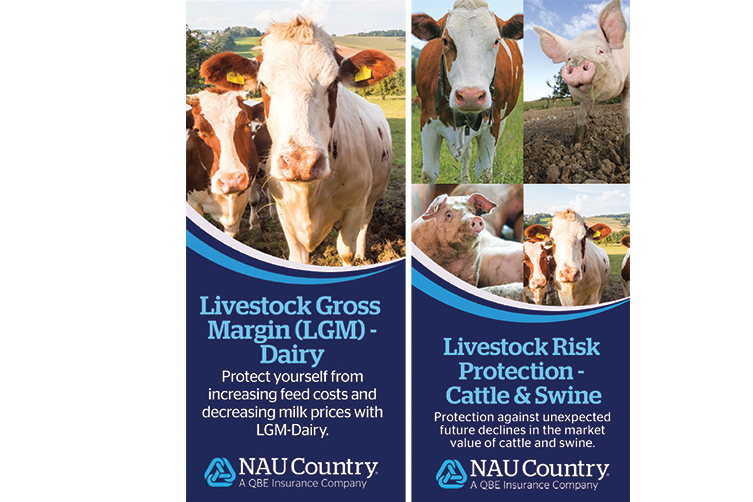Expert Support: Bagley Risk Management Techniques
Wiki Article
Key Variables to Consider When Deciding On Animals Risk Defense (LRP) Insurance Coverage
When assessing options for Animals Risk Protection (LRP) insurance coverage, numerous vital variables require careful factor to consider to make sure effective threat monitoring in the farming industry. Selecting the appropriate insurance coverage choices tailored to your particular animals procedure is critical, as is recognizing exactly how exceptional expenses associate with the level of protection used. In addition, the eligibility standards for different kinds of animals and the flexibility of the policy to adjust to changing situations are important elements to weigh. The efficiency and transparency of the claims process can considerably influence the total experience and economic end results for livestock producers. By strategically navigating these essential aspects, manufacturers can secure their financial investments and alleviate potential dangers effectively.Insurance Coverage Options
When taking into consideration Animals Danger Defense (LRP) insurance policy, it is essential to recognize the various coverage options available to reduce dangers in the agricultural industry. Livestock Threat Security (LRP) insurance provides various coverage options tailored to satisfy the varied needs of livestock manufacturers.One more crucial insurance coverage alternative is the recommendation duration, which establishes the length of time the protection is in impact. Producers can select the recommendation duration that ideal matches their manufacturing cycle and market problems. Additionally, insurance coverage levels and rates vary based upon the kind of livestock being insured, offering manufacturers the versatility to personalize their insurance coverage prepares according to their specific needs.
Comprehending the different insurance coverage options offered under Livestock Danger Defense (LRP) insurance policy is essential for producers to make informed choices that effectively safeguard their animals operations from market uncertainties.
Premium Prices

Livestock Danger Defense (LRP) insurance policy offers essential insurance coverage choices tailored to reduce dangers in the agricultural sector, with a substantial aspect to consider being the calculation and framework of premium prices. When establishing premium costs for LRP insurance policy, a number of variables come right into play. These consist of the kind and number of livestock being insured, the insurance coverage level selected, the existing market value, historic rate information, and the size of the coverage period. Insurance firms may additionally consider the place of the farm, as geographic aspects can affect the total threat account.
Premium expenses for LRP insurance coverage are usually determined based upon actuarial information and run the risk of assessment designs. Insurance companies analyze historical information on livestock prices and production prices to figure out an ideal costs that shows the level of risk entailed. It is necessary for animals manufacturers to very carefully evaluate premium prices and protection choices to ensure they are properly safeguarded against potential financial losses as a result of damaging market problems or unexpected occasions. By comprehending exactly how premium costs are computed and structured, producers can make informed decisions when picking the right you can check here LRP insurance plan for their operation.
Qualified Animals
The decision of qualified animals for Animals Danger Security (LRP) insurance policy coverage involves cautious consideration of certain requirements and qualities. Animals kinds that are generally qualified for LRP insurance policy consist of feeder livestock, fed lambs, cattle, and swine. These animals should meet specific certifications associated with weight ranges, age, and meant usage. In addition, the qualification of animals might differ based upon the details insurance company and the regards to the policy.Feeder livestock, for example, are frequently qualified for LRP coverage if they drop within specified weight varieties. Lambs are an additional category of livestock that can be thought about for LRP insurance, with elements such as weight and age playing a vital duty in identifying their qualification.
Before choosing LRP insurance coverage for animals, producers must very carefully assess the qualification criteria laid out by the insurance company to guarantee their pets meet the necessary requirements for insurance coverage.
Plan Flexibility
Policy adaptability in Livestock Risk Defense (LRP) insurance coverage allows manufacturers to customize insurance coverage to suit their details demands and risk administration methods. This versatility encourages livestock producers to tailor their insurance policy policies based on aspects such as the type of livestock they possess, market problems, and specific danger resistance degrees. By supplying personalized choices, LRP insurance policy allows producers to successfully handle their risk direct exposure while guarding their livestock procedures versus unanticipated market volatility.Insurance Claims Refine
Upon experiencing a loss or damage, producers can initiate the claims procedure for their Livestock Danger Protection (LRP) insurance coverage by promptly calling their insurance policy service provider. It is essential for producers to report the loss as quickly as possible to accelerate the insurance claims process. When getting to out to the insurance coverage company, manufacturers will certainly need to give in-depth details regarding the case, consisting of the day, nature of the loss, and any kind of pertinent paperwork such as vet documents or market costs.
After the assessment is total, the insurance policy copyright will certainly choose relating to the claim and interact the outcome to the producer. If the insurance claim is authorized, the manufacturer will obtain settlement according to the regards to their Livestock Threat Protection (LRP) insurance coverage. Bagley Risk Management. It is important for producers to be acquainted with the claims process to ensure a smooth experience in case of a loss

Conclusion
Finally, when selecting Livestock Risk Defense (LRP) insurance coverage, it is vital to take into consideration insurance coverage options, premium expenses, qualified animals, plan adaptability, and the claims process. These key elements will certainly help make sure that herdsmans and farmers are effectively protected against prospective dangers and losses connected with their livestock procedures. Making a notified decision based on these factors to consider can ultimately cause much better monetary safety and security and comfort for animals manufacturers.view Animals Risk Defense (LRP) insurance policy offers various insurance coverage options customized to satisfy the diverse needs of animals manufacturers.The decision of eligible animals for Animals Threat Defense (LRP) insurance policy coverage involves cautious factor to consider of certain requirements and qualities.Plan flexibility in Animals Threat Protection (LRP) insurance policy permits producers to customize protection to suit their specific requirements and risk monitoring methods.Upon experiencing a loss or damage, producers can launch the insurance claims procedure for their Animals Danger Protection (LRP) insurance policy by immediately calling their insurance company.In conclusion, when selecting Animals Threat Protection (LRP) insurance coverage, it is vital to consider protection choices, premium prices, qualified livestock, plan versatility, and the claims process.
Report this wiki page